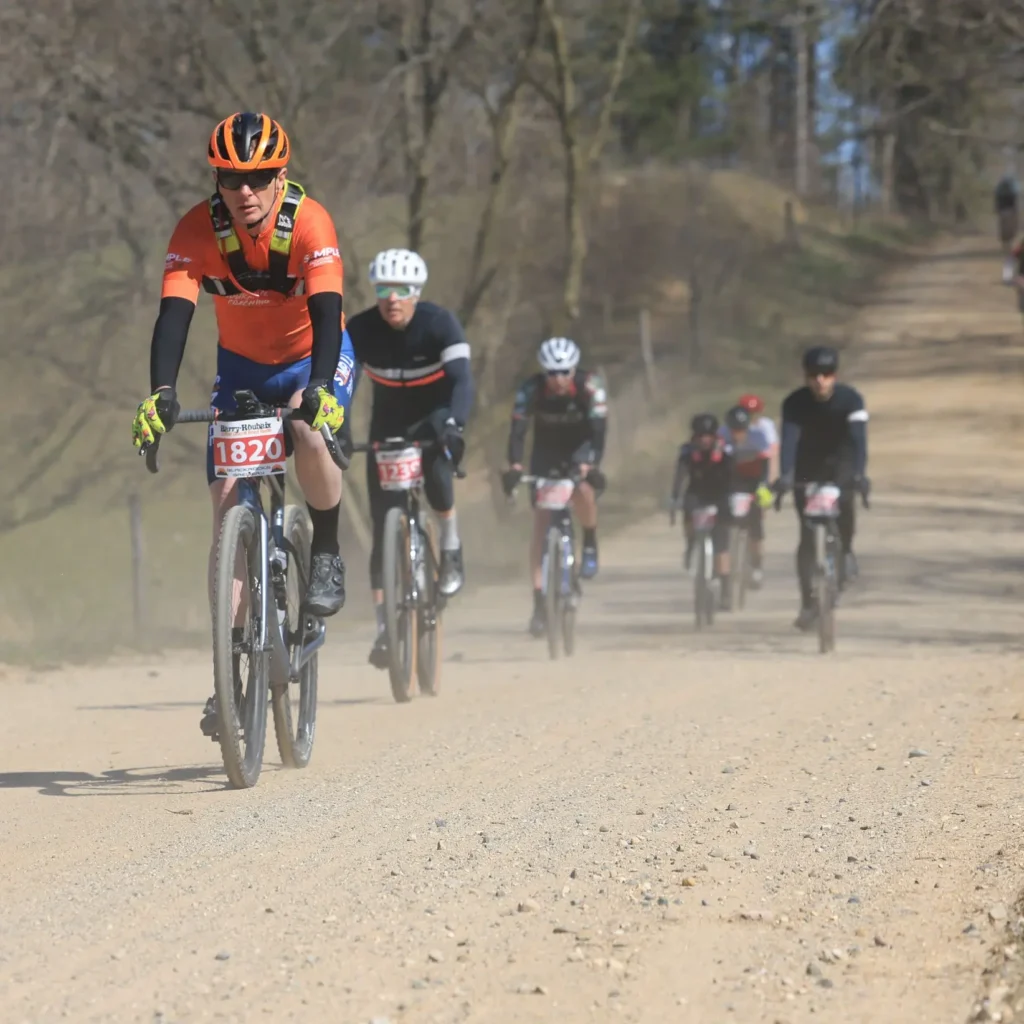Research backs strength training for masters cyclocross racers to boost speed, power
Are you a master’s cyclocross racer looking to take your performance to the next level?
If yes, then incorporating strength training into your routine could be the game-changer you need.
By building strength and power in key areas of your body, you can enhance your riding skills, overcome obstacles with ease and increase speed on even the toughest terrain.
But where do you start?
In this blog post, we’ll explore some of the best practices for incorporating strength training into your cyclocross routine so that you can unlock new levels of success on the course!

Masters cyclocross is fast, furious, and fun
In cycling, the term “masters” typically refers to athletes who are over a certain age (often 35 or 40) and compete in age-group races.
So, masters cyclocross racers are women and men who are over a certain age and compete in masters-level competitions.
These races are generally less chaotic and safer than category-based racing, as most masters athletes have day jobs, families, and other external obligations that make it difficult for them to devote as much time to training and racing as younger, professional athletes.
But masters races often include former pros and other fast people so the competition can be fierce.
We always want to support masters riders reach their full potential.
And strength training for cyclocross racers over 50 is critical.
What does the research say about the effectiveness of strength training for masters cyclocross racers?
Here are three studies that have examined the effectiveness of strength training for masters cyclocross racers:
- A study published in the Journal of Strength and Conditioning Research found that eight weeks of lower body strength training (2-3 sessions per week) improved sprint performance in 12 competitive female cyclocross racers aged 35-45 years old. The researchers concluded that strength training may be an effective way to enhance performance in masters cyclocross racers.
- Another study published in the European Journal of Sport Science examined the effects of strength training on cycling performance in 19 recreational masters cyclists aged 55-63 years old. The participants underwent a 12-week periodized strength training program, and the results showed significant improvements in cycling power output, endurance capacity, and maximal oxygen uptake (VO2max). The authors concluded that strength training could be an effective way to improve cycling performance in masters athletes.
- Finally, a review article published in Sports Medicine analyzed multiple studies on the effects of strength training on endurance performance. The authors concluded that strength training can improve endurance performance by enhancing muscle strength, power, and efficiency, as well as reducing the risk of injury. However, they also noted that the type, frequency, and intensity of strength training should be tailored to the individual athlete’s needs and goals.
So strength training can improve overall performance, cycling power, endurance capacity, VO2max, overall strength, and cycling efficiency.
Plus it helps you stay injury-free, which, over a long cross season, can mean the difference between getting on the podium and not racing.
Strength training for cyclocross racers over 50 should include full-body work
Research suggests that there are several strength training exercises that can be effective for masters’ cyclocross racers.
Here are five of the most effective exercises and why they are effective:
- Squats: Squats are a compound exercise that targets multiple muscle groups, including the quadriceps, hamstrings, glutes, and lower back. Squats are effective for improving leg strength and power, which can help cyclocross racers tackle steep hills and technical terrain. Additionally, squats are a functional movement that can improve overall athleticism and injury prevention. I always recommend doing Goblet Squats to improve back strength.
- Deadlifts: Deadlifts are another compound exercise that targets the lower back, glutes, hamstrings, and quadriceps. Like squats, deadlifts are effective for improving leg strength and power. They also have the added benefit of strengthening the back muscles, which can improve posture and reduce the risk of back injuries. I recommend doing sumo deadlifts with a wide stance to target your side butt muscles.
- Lunges: Lunges are a unilateral exercise that target the glutes, quadriceps, and hamstrings. By working one leg at a time, lunges help to correct any strength imbalances between the legs, which can improve overall performance and reduce the risk of injury. Lunges can also improve balance and stability, which is important for technical cyclocross courses.
- Plyometrics: Plyometric exercises, such as box jumps and depth jumps, are explosive movements that improve power and speed. Plyometrics can help cyclocross racers with quick accelerations, steep hills, and explosive efforts such as jumping over barriers. Plyometrics should be incorporated into a training program gradually, with an emphasis on proper form and minimizing the risk of injury.
- Core exercises: Core exercises such as planks, side planks, and Russian twists can improve overall stability and balance, which is important for maintaining good technique during cyclocross races. Core exercises also help to strengthen the muscles that support the spine, which can improve overall posture and reduce the risk of back pain and injury.
Masters’ cyclocross racers can incorporate strength training into the off-season
There is no one-size-fits-all answer to the frequency of strength training sessions for masters cyclocross racers during the off-season, as it can vary based on individual goals, schedules, and training programs.
However, research suggests that incorporating regular strength training sessions can be beneficial for masters athletes to prevent injury, maintain muscle mass, and improve performance.
According to a review published in Sports Medicine, masters athletes should aim to perform strength training exercises 2-3 times per week during the off-season to achieve optimal results.
The authors of the review also suggest that athletes should focus on exercises that target the muscles used in cyclocross racing, such as the legs, hips, core, and upper back.
Another study published in the Journal of Aging and Physical Activity found that a 12-week resistance training program consisting of full-body exercises performed twice weekly was effective at improving muscular strength and power in older adults.
While this study did not specifically examine masters cyclocross racers, the results suggest that a twice-weekly strength training program could be effective for improving overall strength and power in older athletes.
Overall, the research suggests that masters cyclocross racers can benefit from incorporating regular strength training sessions into their off-season training program, with a frequency of 2-3 sessions per week being recommended for optimal results.
In-season strength training for cyclocross
In-season strength training is a topic of debate among coaches and athletes in various sports.
However, research suggests that maintaining a reduced frequency of strength training (1-2 sessions per week) during the season can be beneficial for masters cyclocross racers.
One study published in the International Journal of Sports Medicine found that maintaining a strength training program during a 10-week cycling race season improved endurance performance and maximal strength compared to a group that did not perform strength training.
The study involved 15 cyclists, including masters-aged athletes, who performed two strength training sessions per week in addition to their cycling training during the competitive season.
The researchers concluded that maintaining strength training during the season can lead to improvements in endurance performance and maximal strength.
Another study published in the Journal of Strength and Conditioning Research examined the effects of concurrent strength and endurance training on cycling performance in masters athletes during the competitive season.
The results showed that a combined endurance and strength training program led to greater improvements in peak power output and time-to-exhaustion compared to endurance training alone.
The study suggests that concurrent strength training during the season can improve cycling performance.
Overall, while the frequency of strength training may be reduced during the season, incorporating at least one or two weekly strength training sessions into an athlete’s training program can help maintain muscle mass, prevent injury, and improve performance.
Designing the in-season strength training program to complement the athlete’s racing schedule and overall training program is important.
Scheduling your strength training into your training plan
The optimal way to incorporate strength training into a weekly training plan for masters cyclocross racers can vary based on individual goals, schedules, and preferences.
However, research suggests that there are several effective ways to integrate strength training into a weekly training plan.
One approach is to do strength training sessions on the same day as lower-intensity endurance rides or active recovery days.
This can help reduce post-workout fatigue and give the athlete time to recover before more intense workouts later in the week.
For example, a master’s cyclocross racer could perform a strength training session in the morning and follow it with an easy endurance ride or active recovery session in the afternoon or evening.
Or an athlete can double up with strength and intervals on the same day.
This can help maximize recovery time between workouts while still allowing for adequate rest and recovery.
For example, a master’s cyclocross racer could perform a high-intensity interval workout in the morning, followed by a strength training session in the afternoon or evening.
I usually suggest my athletes do their strength training sessions after high-intensity interval workouts or hill repeats.
Regardless of when strength training sessions are performed, it is important to ensure that athletes have adequate rest and recovery time between workouts.
This may mean spacing out strength training sessions throughout the week and avoiding consecutive days of high-intensity strength training or cycling workouts.
Additionally, the specific exercises and intensity of the strength training program should be tailored to the athlete’s individual needs and goals.
Individualize your plan for your goals, schedules
Overall, the most effective way to incorporate strength training into a weekly training plan for masters cyclocross racers will depend on the individual athlete’s goals, schedules, and preferences.
Be sure to focus on compound exercises that work multiple muscle groups simultaneously.
This will help you develop functional strength that will transfer well to your cycling.
And be sure to give your body adequate time to recover between strength training sessions so that you don’t overtrain and risk injury.
Each session should last 30-60 minutes, and you should build up to heavy weight with just a few reps.
For example, once you’ve been lifting for a while, work on three to four sets of five heavy deadlifts.
Another important thing to keep in mind is the principle of progressive overload.
This principle states that in order to see results from your strength training, you need to gradually increase the amount of weight or resistance you are lifting over time.
Strength training should be an important part of any older cyclist’s routine, especially those racing cyclocross.
By incorporating strength exercises into your weekly training regimen, you can improve your overall performance and ensure that you stay healthy while competing.
Cross is coming!
Three things to know about strength training for masters cyclocross racers
- The research is abundant and clear: Strength training helps build speed, power, snap, and improves durability.
- Focus on full-body strength training exercises like front squats and deadlifts.
- Older cyclocross racers should lift all year long.
Need more about strength training for masters cyclocross racers??
Sign up for Virtual Coffee so we can discuss your goals, ask questions, and talk about making your endurance training more effective, fun, and Simple.
Get a free Core Strength and Stability training video when you opt-in to receive my weekly blog posts about what works in endurance sports.
Paul Warloski is a:
- USA Cycling Level 3 Coach
- RRCA Running Coach
- Training Peaks Level 2 Coach
- RYT-200 Yoga Instructor
- Certified Personal Trainer





